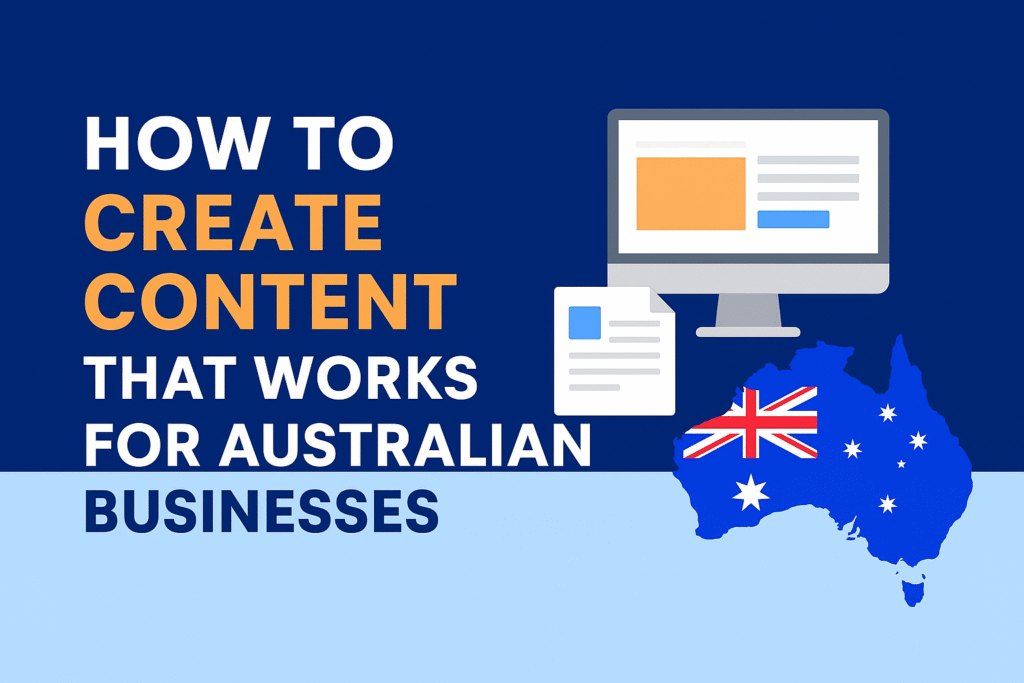Introduction
In today’s competitive digital landscape, Australian businesses can’t rely on word-of-mouth alone. Whether you’re a local café in Melbourne, an eCommerce startup in Sydney, or a digital agency in Brisbane — the key to standing out online is creating content that truly connects with your audience. But not all content works.
The real challenge is crafting content that converts — content that builds trust, engages customers, and ranks on search engines. In this guide, we’ll explore how Australian businesses can create content that performs, using strategies proven to work in the local market.
1. Understand Your Audience — The Australian Way
Before writing a single word, understand who you’re talking to. Australian audiences value authenticity, practicality, and local relevance. They don’t want exaggerated marketing; they want real value.
Ask yourself:
- What problems does my audience face?
- What tone do they respond to — formal or conversational?
- What local references or examples will make them feel connected?
For example, if you’re targeting small businesses in Melbourne, include examples like “digital marketing for Melbourne cafés” or “SEO tips for Sydney startups.” Local references make readers feel like you understand their world — and that builds instant trust.
2. Research Keywords That Reflect Local Intent
To make your content visible, you need the right keywords. But here’s the secret: focus on local keywords that Australians actually search for.
Instead of generic phrases like “content marketing services,” use location-specific or intent-based keywords such as:
- content creation services in Australia
- SEO-friendly blogs for small businesses
- digital marketing in Australia
- social media management for Australian brands
Use keyword research tools like Google Keyword Planner or Ubersuggest to find trending terms. Then, integrate them naturally throughout your blog — in your title, headings, and body paragraphs — without overstuffing.
Smart Web Services, for instance, uses these keywords across its site to target local businesses effectively.
3. Create Value-Driven Content, Not Clickbait
The best content does one thing: provides value. Australian readers appreciate content that teaches them something useful rather than simply selling.
Types of value-driven content:
- How-to guides (e.g., “How to Boost Your Local SEO in 30 Days”)
- Case studies (show how your service helped an Australian business)
- Industry insights (share data or trends relevant to your niche)
- Step-by-step tutorials (help users take action right away)
The goal is to educate first and sell later. When you help your audience solve a problem, they remember your brand as trustworthy and knowledgeable.
4. Keep It Local and Culturally Relevant
Localisation isn’t just about adding “Australia” to your keywords. It’s about reflecting Australian culture, tone, and context in your content.
Here’s how to keep it authentic:
- Use Australian English (optimise, not optimize; favourite, not favorite)
- Reference Australian cities, events, or seasons (e.g., “summer sale season in Perth”)
- Include local stats or examples (e.g., “over 80% of Australian shoppers research online before buying”)
- Reflect the friendly, approachable Aussie tone — be conversational, not corporate
When your content sounds local, it feels personal. And that’s what drives engagement.

5. Focus on SEO-Friendly Structure
Search engines and humans both love well-structured content. A clean layout improves readability and helps your page rank higher.
Here’s the ideal structure:
- Headline — clear and keyword-focused
- Intro paragraph — summarise what the article will deliver
- Subheadings (H2, H3) — break down ideas for easy scanning
- Short paragraphs — 2-4 lines max
- Internal links — connect to related pages (e.g., your service or blog posts)
- Strong call-to-action (CTA) — invite users to contact or learn more
For example, link to Smart Web Services’ Content Creation Services in Australia page within your blog to encourage conversions.
6. Mix Content Formats for Maximum Impact
Not everyone likes reading long blogs. Some prefer visuals, videos, or quick infographics. So, diversify your content to reach different audiences.
Here’s what works best in Australia:
- Blog posts: For detailed explanations and SEO ranking.
- Videos: For quick storytelling and social media reach.
- Infographics: For bite-sized information and sharing.
- Social snippets: For engagement and brand recall.
- Email newsletters: To nurture long-term customer relationships.
Combine these formats in a single campaign — for example, publish a blog, create a short video summarising it, and share snippets across social media platforms.
7. Be Consistent — That’s the Secret Ingredient
Content marketing isn’t a one-time task; it’s an ongoing process. Australian businesses that post consistently perform better in brand visibility and organic ranking.
A simple content schedule could be:
- 2 Blogs per month
- 4 Social media posts per week
- 1 Newsletter per month
The more consistent your message, the stronger your brand authority becomes. Smart Web Services’ own blog follows this consistency — with regular updates that keep the audience informed and engaged.
8. Measure, Analyse, and Improve
Creating content is just step one. The real growth comes when you analyse performance.
Track these key metrics:
- Website traffic (Google Analytics)
- Keyword ranking (Google Search Console)
- Engagement rate (time on page, bounce rate)
- Conversion rate (leads, sign-ups, purchases)
If a topic performs well, create more around it. If a post doesn’t engage, update it with stronger visuals, new keywords, or better CTAs. Remember — content that works evolves over time.
9. Leverage Local SEO for Better Reach
To make your content more discoverable in Australia:
- Add Google Business Profile links.
- Use location-based meta descriptions (e.g., “Expert digital marketing for Sydney small businesses”).
- Get listed in local directories.
- Encourage local backlinks from Australian partners or bloggers.
Local SEO ensures your business shows up when nearby customers search for your services — giving you a competitive edge.
10. End Every Piece with a Purpose
Every piece of content should guide the reader to take an action — whether that’s downloading a guide, contacting your team, or following you on social media.
A strong call-to-action could be:
“Need help creating SEO-friendly content for your Australian business? Contact Smart Web Services today to boost your brand visibility.”
That’s how you convert casual readers into loyal customers.

Conclusion
Creating content that works for Australian businesses isn’t about using fancy words — it’s about delivering value, staying authentic, and thinking local.
From understanding your audience and researching Australian-specific keywords to structuring SEO-friendly blogs and promoting across channels, every step plays a role in your success.
When done right, content becomes more than marketing — it becomes your brand’s voice, authority, and trust-builder in the digital world.
So start today. Write with purpose. Optimise for your audience. And let your content do the selling for you.



